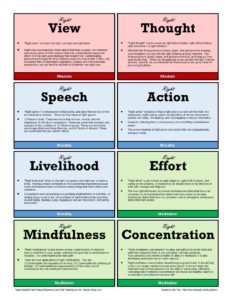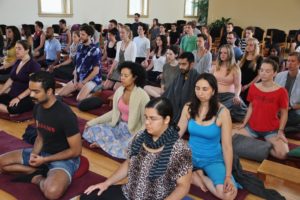
Democracy on the Eightfold Path
By John M. de Castro, Ph.D.
“It is important to realize that a well-functioning democracy — a republic — depends not just on freedom from censorship, but also on a set of common experiences and on unsought, unanticipated, and even unwanted exposures to diverse topics, people, and ideas. A system of “gated communities” is as unhealthy for cyberspace as it is for the real world.” ~Scott Meyer
With the US midterm elections on the horizon, I thought that it would be a good time to reflect on what the teachings of the Buddha tell us about how we should approach voting and engaging in the democratic process in general. Right now, the political landscape is characterized by tremendous rancor and division. I believe that this situation results from not following these teachings. Perhaps looking at their application to engaging in the democratic process will help us in the future to begin to heal the deep wounds that have been opened and begin to engage in a more constructive and beneficial political process.
We often think of meditation or spiritual practice as occurring in quiet places removed from the hubbub of life. This is useful to develop skills and deep understanding. Unfortunately, most people do not have the luxury of withdrawing into solitary or monastic life. But it is possible to practice even in the midst of the chaos of everyday life. In fact, there are wonderful opportunities to practice presented to us all the time in the complexities of the modern world. I find that engagement in democracy is one of many wonderful contexts in which to practice the Buddha’s Eightfold Path, the Buddha’s prerequisites for the cessation of suffering; Right View, Right Intentions, Right Actions, Right Speech, Right Livelihood, Right Effort, Right Mindfulness, and Right Concentration. Engaging in democracy on the eightfold path can not only help our spiritual practice but also help further peace, happiness, and harmony in our society.
Engagement in democracy is a wonderful opportunity to practice Right View. The impermanence of everything is on display. No matter how bad or good the political situation is we can be sure that it will change. This is especially true with democracy where the ability to change the current laws or leadership is its strength. If we don’t like it, we have a route to try to change it. By recognizing this we not only practice Right View but also relax and accept what is. Democracy is also a situation that reflects how interconnected everything is. Engagement in democracy is a cooperative social venture. Without everyone’s cooperation, there would be political chaos. Each of us has only one vote. The outcome of an election depends upon the votes of many. But beyond that democracy can only function if everyone cooperates and accepts the decision of the majority.
In the context of democracy, if we take a moment to look, it is easy to develop Right View. We can view the transitoriness of our thoughts and emotions as they arise and fall away in response to the election process and political debate. We may become very worked up about an issue, but see that these feelings are only temporary and will subside in a short time. We can see that our political identity as Democrat or Republican, as conservative or liberal, or any other label is never truly accurate and is subject to change. We can see that there is no permanent thing that is our political self and that is also true for others. This is a tremendous learning experience and laboratory to not only personally develop Right View, but to help develop Right View in our society.
Engagement in democracy allows us to observe our suffering, unsatisfactoriness, and its roots. We seem to want our system and its outcomes to be exactly as we want them to be and when they are not we suffer. We want other voters to think the way we do, for our candidates to always win, we want the laws passed to always match our world view and beliefs, we want the media to always present arguments in favor of our positions, etc. In other words, we can learn, if we are observant of what is happening during participation in democracy, that our suffering is caused by our lack of acceptance of how things are. So, political engagement constitutes a laboratory to practice Right View. We can learn to accept things as they are, to see things without judgment, to view the others just as they are, and to understand how we vote has consequences, affecting ourselves and others, in other words, we learn Right View.
We can quite readily practice Right Intentions while engaging in democracy and this can lead to Right Actions. Right Intentions involves targeting what we do to increase peace, happiness, prosperity, and happiness in ourselves and throughout society. These intentions include the abandonment of unwholesome desires. If we engage in the democratic process with anger, impatience, selfishness, resentment we are likely to harm others and ourselves. The harm may not be major or direct, but indirect by affecting the other citizens in negative ways. Perhaps interrupting another while arguing their position produces anger in them that causes them suffering and elicits anger and aggression from them toward the positions of others. Perhaps, not simply listening to others ideas may unnecessarily cause them to suffer and induce impatience and an inability on their part to simply listen to others. But sometimes direct physical harm to others can be produced as in the case of violent political protests or confrontations with people with whom we strongly disagree. But if we practice Right Intentions with sincere intentions to create good and happiness, relieve suffering in ourselves and others, and not harm any living thing, we will act and interact with our fellow citizens with courtesy, with tolerance and understanding, with kindness and good will. When listen deeply to another’s position and try to understand it or react to an aggressive political post on social media with patience and tolerance, we may have prevented harm. Had the reaction be angry or judgmental it might provoke even more divisive or aggressive actions in response, creating an upward spiral of anger and frustration. It is good to reflect on the ripples of good that may have been created through Right Actions with unknown consequences extending broadly well into the future.
Intentions are a key. They become our moral compass. They tend to lead us in the right direction even though we may at times stumble. It is often difficult or impossible to predict all of the consequences of our actions. It is also very difficult not to create some harm. Just the fact of taking positions and backing certain candidates can result in an ineffectual or even corrupt candidate being elected or damaging laws being passed. We need to try to not only have Right Intentions, but to discern and accept that even the best of intentions can sometime produce harmful outcomes. We have to sometimes balance the good we’re doing with the harm produced by the same actions. This requires Right Intentions. This is where engaging in politics can be such a great practice as we can learn what works and what doesn’t and become better at discerning what are the wholesome Right Actions from those that produce more harm than good. But, if we form Right Intentions and aspire to create good and happiness we’ll be better citizens and will produce more harmony and good will and more importantly will be moving ourselves along the eightfold path.
Verbal interactions are a fundamental process in a democracy, providing many opportunities to practice Right Speech. Political discussions, like any discussion include communicating ideas and feelings both verbally and also non-verbally. Non-verbal communications include facial expressions and body postures. I have a bad habit of often reacting with grimaces or looking away when someone presents a point I don’t agree with. This obvious non-verbal judgement of the others position can harden their position making it more difficult to truly discuss the issue. But, predominantly Right Speech is verbal. I have another bad habit of often getting very frustrated when in a discussion, someone presents, as true, a different set of facts than I believe to be true. It becomes impossible to have an honest discussion when the underlying facts differ. I often react reflexively with anger and frustration and blurt out something like “that’s not true.” This cuts off the possibility of listening deeply to the other’s ideas and short circuits the possibility of a reasoned discussion of the facts. This does no good and often aggravates others. Practicing Right Speech involves engaging in civil, respectful discourse. The facts, beliefs, and conclusions can be questioned and discussed but simply as a difference and not judged as good or bad, right or wrong, just simply a difference that can be investigated and resolved. For me, this is a work in progress. I have a long way to go. But I can clearly feel the benefits for myself and for the quality of the interaction when I am mindful and engage in Right Speech.
Right Speech is non-violent and non-judgmental speech. So much political discourse involves trying to be right or to convince someone of your position. Right Speech, on the other hand, is directed to understanding and producing good feelings. Here, deep listening is a key. It is impossible to respond appropriately to another if you haven’t listened carefully to exactly what the other said. We, too often, spend our time while another is speaking composing our next speech for whenever they stop. This doesn’t allow deep listening and can poison a conversation. Political Right Speech involves listening as much as talking and what is said is directed to improving harmony and understanding. This is a lofty goal that few of us are able to achieve. But, striving in that direction will make us better citizens.
Being a politician can be itself Right Livelihood. It can be directed to creating good, helping people, keeping peace, and moving society forward in a positive direction. It is not ours to judge the “rightness” of politicians. This is a personal matter where intention matters, that must be reflected upon deeply. But representational democracy is a system that demands that members of the society make their living as the people’s representatives. This is important and can create great good for the society. If it is Right Livelihood and adheres to the seven other components of the eightfold path it helps the individual in their personal development and the development of the greater society.
Once again, engagement in democracy presents a fine context to practice Right Effort. It takes substantial effort to be an engaged citizen. If one simply assumes that their right without doing the hard work of learning the facts, there is little or no mindfulness and little or no effort. When we first engage politically we have to set the intention to act in such a way as to lessen suffering in ourselves and others. We need to interact with other people with kindness, compassion, patience, and courtesy, to drop fear, anger, hatred, and selfishness, and to bring to our political interactions with others the intention to promote well-being and happiness. This is hard and requires Right Effort. But, we can try too hard. Right Effort involves acting according to the “Middle Way.” That is, not trying too hard and getting stressed about politics, but also not being lackadaisical, rather it involves relaxed effort. The “Middle Way” is where effort should be targeted. But, nonetheless effort is needed. Democracy cannot function without an informed electorate and in today’s information age it can be devilishly difficult work to discern the truth. Right Effort on the part of citizens is not only needed but essential to the successful operation of democracy.
Democracy requires an accurate understanding of the nature of the current situation in order to determine what political steps are needed to promote good, happiness, and harmony. Unfortunately, mindless political engagement is probably the norm. Rather than seeing things as they are, we tend to view society through a lens of how it was in the past, or how we believe it should be. But, this can be corrected by the practice of Right Mindfulness. Jon Kabat-Zinn defined mindfulness as “paying attention on purpose, in the present moment, and nonjudgmentally, to the unfolding of experience moment to moment.” What better opportunity to practice this than in seeing what is present right in front of us right now in our society and with the people who compose it? Right Mindfulness makes us acutely aware of what is happening around us and how we’re feeling during every moment of our day; seeing the situation accurately, unclouded by beliefs or prejudgment. This allows us to better craft ideas and solutions to the ills of society. Seeing a welfare recipient, a homeless person, or a prisoner as a person and their situation as it actually is and not judging the individual based upon our political beliefs and social media memes, we can much better understand what is the truth and what can best be done to help. Right Mindfulness provides the data to engage politically. Right Mindfulness is not just part of the eightfold path it is a prerequisite for the practice of the seven other components of the path. So, being mindful is fundamental to all aspects of political engagement.
Right Concentration” is the practice of focusing the mind solely on one object or a specific unchanging set of objects. Mindfulness is paying attention to whatever arises, but concentration is paying attention to one thing to the exclusion of everything else. This is usually developed during contemplative practice such as meditation and is nearly impossible to practice in real life. But, improvement in attentional ability is a consequence of practicing Right Concentration. This can lead to improved political engagement. It can reduce the impact of distractions and mind wandering, making us better at focusing on the topic at hand and increasing the likelihood that we’ll discern the best course of action. In addition, Right Concentration requires Right Effort, Right Intention, and Right Mindfulness so these can be developed while applying Right Concentration to our political activities. In a political discourse, there is often a jumping around from topic to topic without every reaching a conclusion about any of them. Right Concentration can be the antidote, allowing for focus and hopefully resolution.
Engaging in democratic activity on the eightfold path is not easy. But, remember that it is a practice. Over time I have gotten better and better at it, but nowhere near perfect. Frequently the discursive mind takes over or my emotions get the better of me. But, by continuing the practice I’ve slowly progressed. I’ve become a better at discussing politics with others and I’ve become better at seeing what needs to be accomplished in our society. I’ve become better at seeing people with different ideas and beliefs not as the enemy but simply as worthy people who simply hold different opinions that I can learn from. I am learning to be relaxed with a smile on my face when I engage politically and enjoy being part of a democracy where diversity of people and ideas is not a problem but a strength.
Can we attain enlightenment through political engagement? Probably not! But we can practice the eightfold path that the Buddha taught leads there. The strength of engaging in democracy with the practices of the eightfold path is that it occurs in the real world of our everyday life. Quiet secluded practice is wonderful and perhaps mandatory for progress in spiritual development. But for most people it only can occur during a very limited window of time. By extending the practice directly into the mainstream of our lives we can greatly enhance its impact. I like to keep in mind the teaching that actions that lead to greater harmony and happiness should be practiced, while those that lead to unsatisfactoriness and unhappiness should be let go. Without doubt, by practicing the eightfold path in our engagement in politics leads to greater harmony and happiness and as such should definitely be included in our spiritual practice.
“To engage in politics—the system through which we take care of one another—is to bring mindfulness outward. To participate, to speak out, is to address the complexities of our modern world.” ~Lisette Cheresson
CMCS – Center for Mindfulness and Contemplative Studies
This and other Contemplative Studies posts are also available on Google+ https://plus.google.com/106784388191201299496/posts and on Twitter @MindfulResearch









